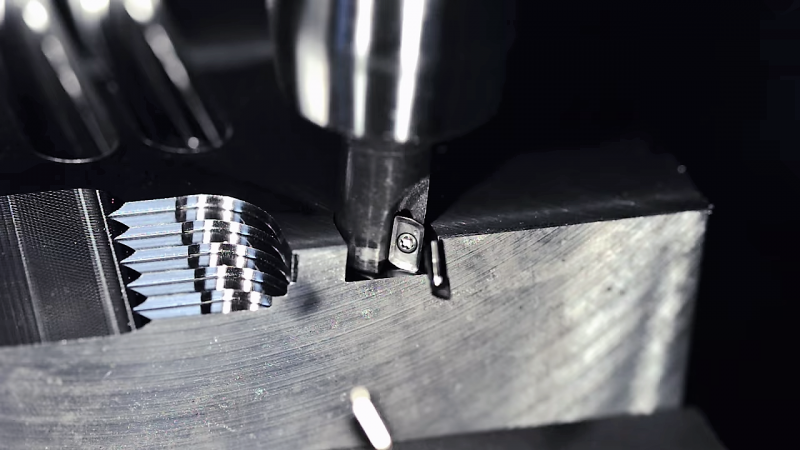It seems a touch ironic that one of the main consumables in the machining industry is made out of one of the hardest, toughest substances there is. But such is the case for tungsten carbide inserts, the flecks of material that form the business end of most of the tools used to shape metal. And thanks to one of the biggest suppliers of inserts, Sweden’s Sandvik Coromant, we get this fascinating peek at how they’re manufactured.
For anyone into machining, the video below is a must see. For those not in the know, tungsten carbide inserts are the replaceable bits that form the cutting edges of almost every tool used to shape metal. The video shows how powdered tungsten carbide is mixed with other materials and pressed into complex shapes by a metal injection molding process, similar to the one used to make gears that we described recently. The inserts are then sintered in a furnace to bind the metal particles together into a cohesive, strong part. After exhaustive quality inspections, the inserts are ground to their final shape before being shipped. It’s fascinating stuff.
Coincidentally, [John] at NYC CNC just released his own video from his recent jealousy-inducing tour of the Sandvik factory. That video is also well worth watching, especially if you even have a passing interest in automation. The degree to which the plant is automated is staggering – from autonomous forklifts to massive CNC work cells that require no operators, this looks like the very picture of the factory of the future. It rolls some of the Sandvik video in, but the behind-the-scenes stuff is great.
Thanks to [Tod E. Kurt] for the heads up on the Sandvik video.

















“The degree to which the plant is automated is staggering – from autonomous forklifts to massive CNC work cells that require no operators, this looks like the very picture of the factory of the future.”
I know a ball-bearing factory that’s pretty automated.
I bet it just keeps rolling along don’t it…
(I’ll see myself out)
But if you need a REALLY hard material, the next best thing to diamond is cubic boron nitride (CBN). Knoop hardness is about half that of diamond, while tungsten carbide is about a fifth that of diamond. (Fun fact: hard as it is, diamond nonetheless can’t be used for precision machining iron/steel because it forms iron carbide; messes up the cutting edge.)
Unfortunately, price seems to scale exponentially with hardness. Tungsten carbide inserts run around $5-10 each. A good friend owns a machine shop and has a surfacing machine specifically for milling heads. Happily, it uses only one CBN insert, because the last one he ordered from China ran over $200. (He’s my friend for life now because I found a package of ten new American-made inserts from someone who must not have known their value—$45 including shipping.)
“Unfortunately, price seems to scale exponentially with hardness.”
This is actually due to how these materials are made, which is slow and uses a HUGE amount of energy. They are crystals that are grown in laboratory environments by exposing a source material to very high temperatures for an extended duration. If we could harness the power of the sun more efficiently then these materials would be cheap.
Fusion?
Why use the sun when you can make your own? Someday. I really want to see a future with fusion deep-space propulsion, hopefully I’m still alive.
Dan, I try to read every single article you write on Hackaday. I can’t say that for all Hackaday authors. Keep up the great content! Sometimes I swear YouTube must be serving us the same video feeds when I see watched videos resurface!
Anyone remember this?
Mum: How are you liking it down the mine, Ken?
Ken: Oh it’s not too bad, mum… we’re using some new tungsten carbide drills for the preliminary coal-face scouring operations.
Mum: Oh that sounds nice, dear…
Dad: Tungsten carbide drills! What the bloody hell’s tungsten carbide drills?
Ken: It’s something they use in coal-mining, father.
Dad: (mimicking) ‘It’s something they use in coal-mining, father’. You’re all bloody fancy talk since you left London.
Monty Python’s Flying Circus – Working Class Playwright / A Scotsman on a Horse
Ctrl-F “What the bloody hell’s tungsten carbide drills?”
Nothing for me to do here
You can do lots. You can use this tech to drill in mines or drill in concrete. Its cool that the tech goes back far enough that it was mentioned as a great thing back in the 1960’s/70’s when Monty Python was doing its show. Tungnsten carbide drilling and cutting is a wonderful thing. It makes many modern construction techniques possible, and makes this factory a real place of wonders. There’s plenty to do here. Need to ancher that gunsafe to the concrete floor. Tungsten carbide drill bits (along with a hammer drill) are there to make it work. Same goes if you want to run a wire through a concrete/brick wall or precut a crack in floor concrete so it doesn’t crack the wrong way. I was merely bringing up that that crazy band of mostly Brits back in the 60’s got it right in acknowledging the significance of this technology. :-)
Yea, big diamonds are relatively useless compared to the absolutly essential bits of diamond found in these cutting inserts.
They be doing magic in that factory. :-) Wonderful Magic!!